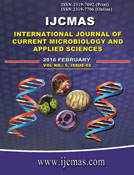


 National Academy of Agricultural Sciences (NAAS)
National Academy of Agricultural Sciences (NAAS)

|
PRINT ISSN : 2319-7692
Online ISSN : 2319-7706 Issues : 12 per year Publisher : Excellent Publishers Email : editorijcmas@gmail.com / submit@ijcmas.com Editor-in-chief: Dr.M.Prakash Index Copernicus ICV 2018: 95.39 NAAS RATING 2020: 5.38 |
Adolescence in girls has been recognized as a special period which signifies the transition from girlhood to womanhood. Globally, adolescent girls constitute about 1/5th of total female population. More than just a physiological process, menstruation may be looked on as a restriction on women’s religious and social traditions or as a taboo. To compare the practices of urban and rural school going adolescent girls regarding menstrual hygiene. It was a descriptive cross sectional study carried out in Government and private schools located in the areas served by UHTC and RHTC of Department of Community Medicine, SRMS IMS, Bareilly (UP). The study was conducted over a period of one year. Adolescent girls studying in 6th to 10th class in selected schools comprised the study population. Inclusion criteria were adolescent girls aged 10–19 years who had attained menarche and were studying in 6th to 10th class in the selected schools. Three-fourth 142 (75.5%) of rural girls were following restrictions during menses as compared to less number of urban subjects 126 (71.6%). The most common restriction followed was not attending religious function as practiced by 73.9% and 66.7% of rural and urban girls respectively. Study on the use of material during menses revealed that the use of sanitary pads was more common among urban adolescent girls (62.5%) compared to rural (35.1%). Most common reason cited for not using sanitary pad was high cost as reported by 42.6% and 43.9% of rural and urban girls respectively. Overall menstrual practices were better in urban as compared to rural girls.
 |
 |
 |
 |
 |